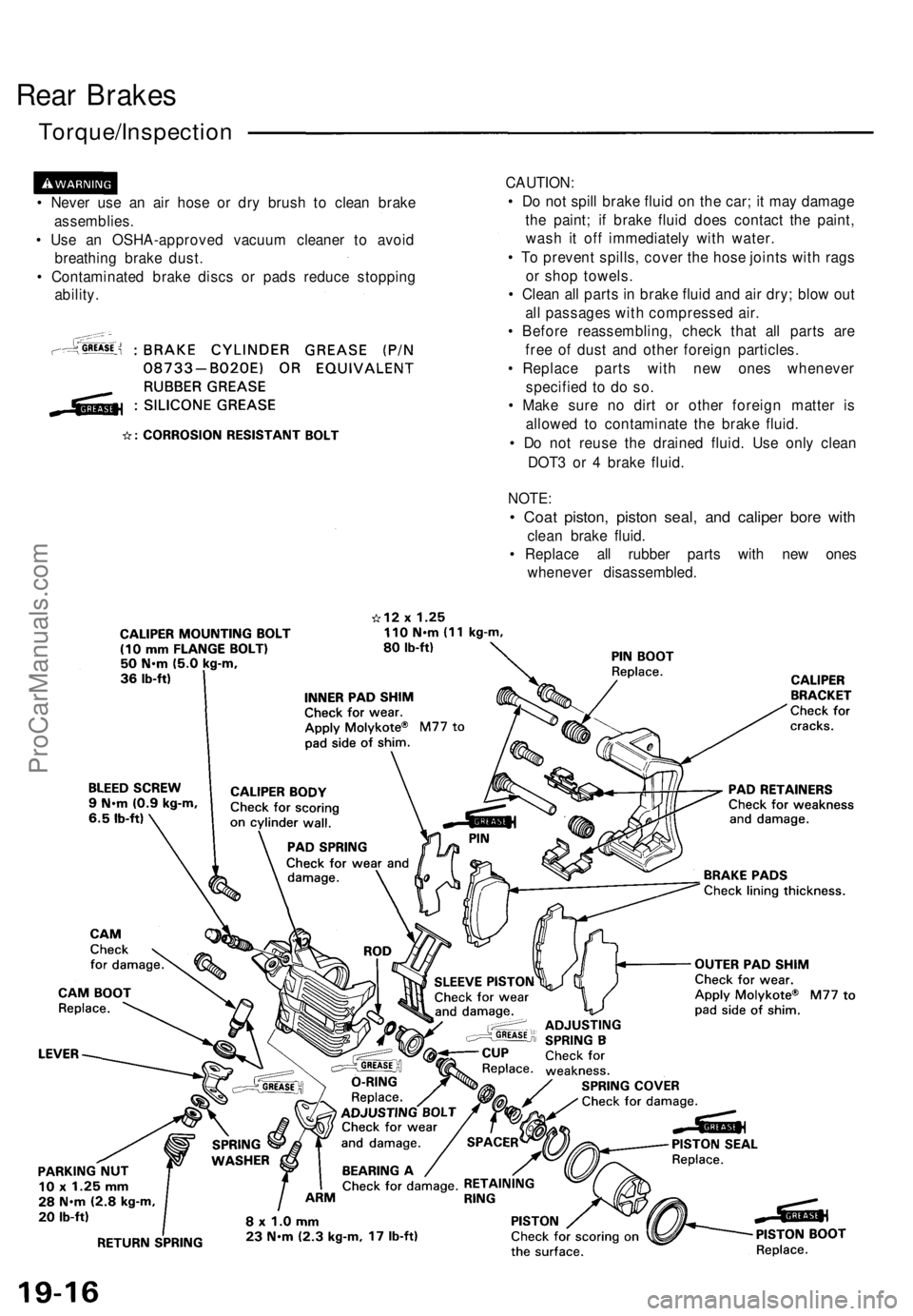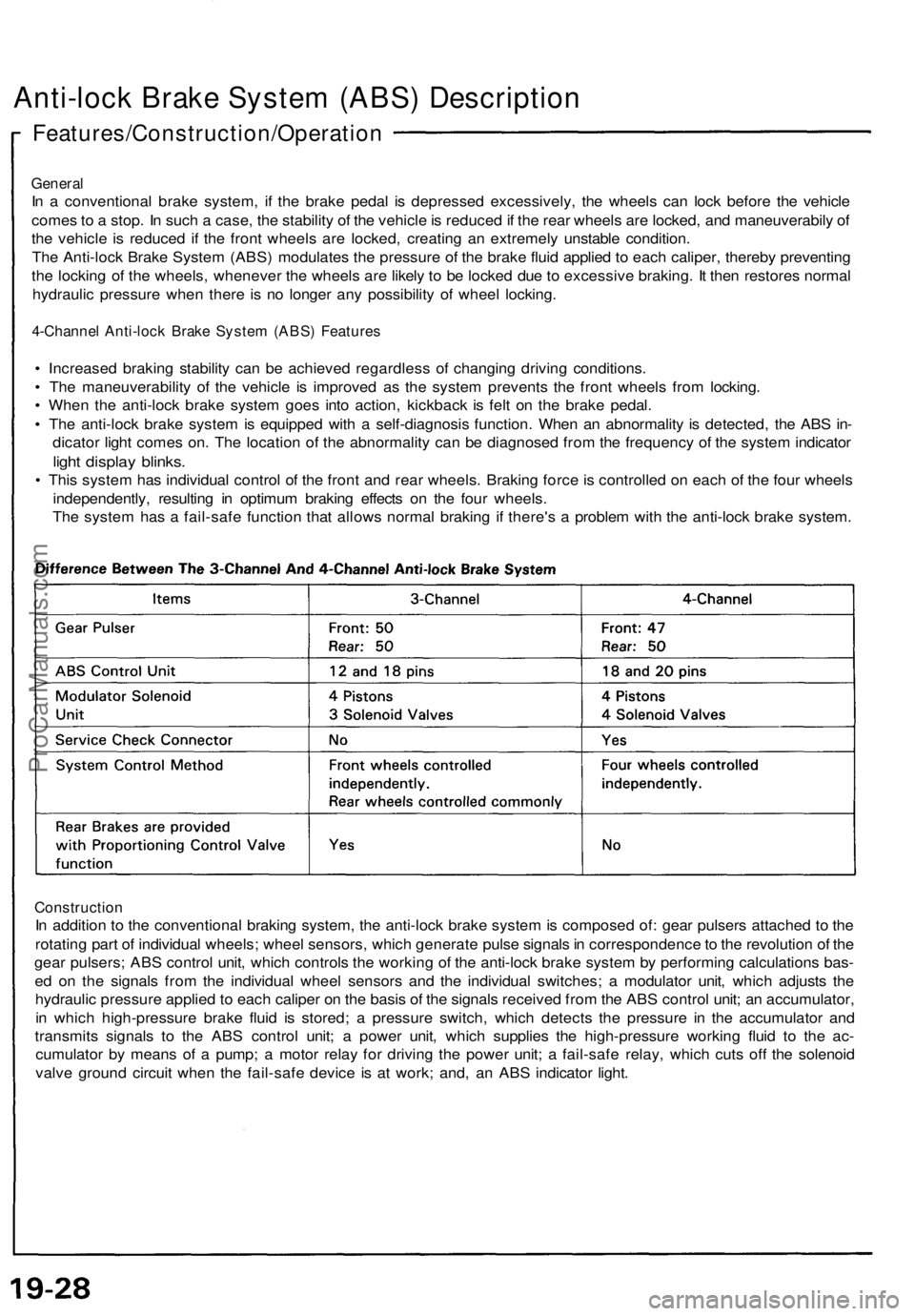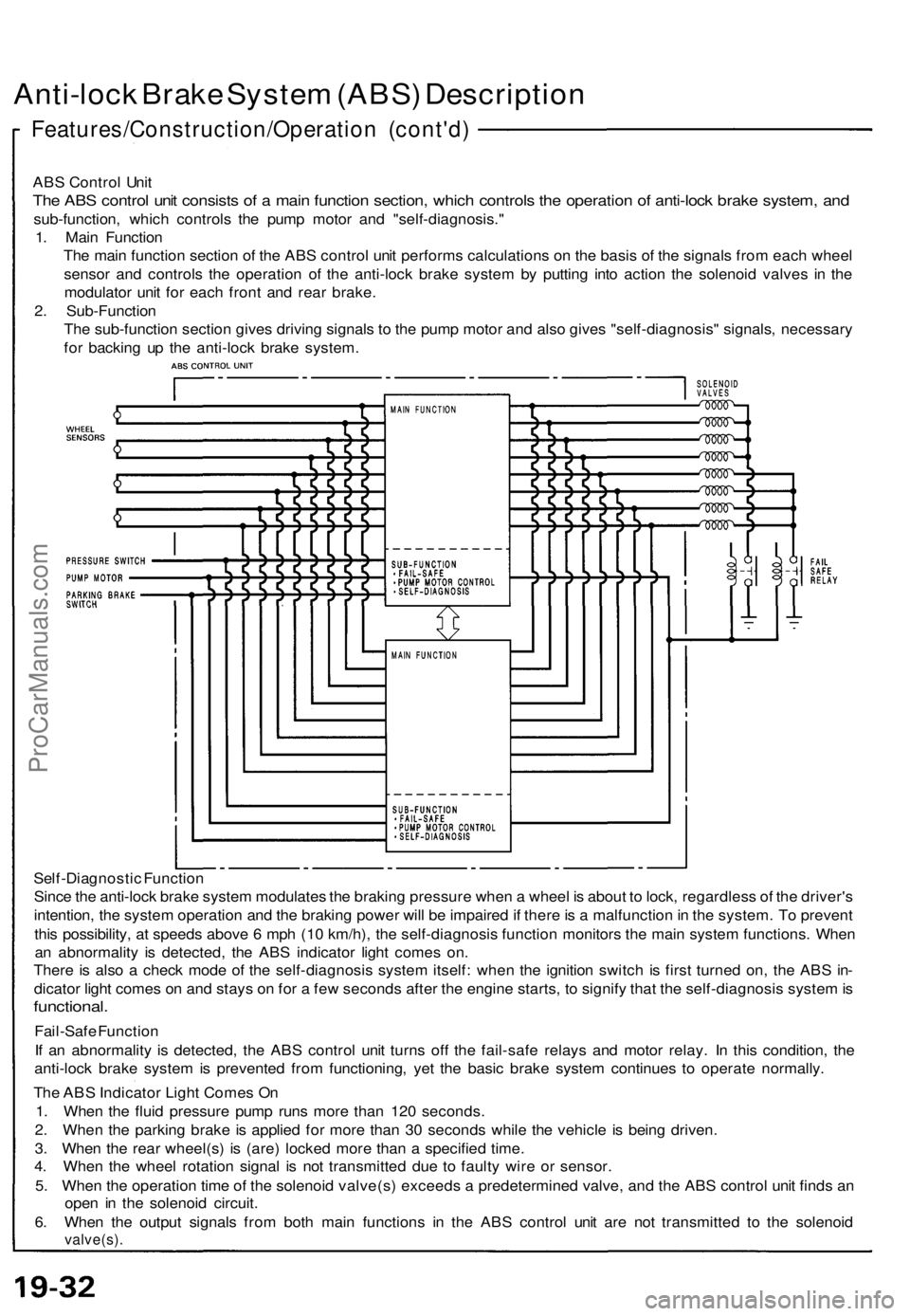Page 504 of 1640

Rear Brakes
Torque/Inspection
• Never use an air hose or dry brush to clean brake
assemblies.
• Use an OSHA-approved vacuum cleaner to avoid
breathing brake dust.
• Contaminated brake discs or pads reduce stopping
ability.
CAUTION:
• Do not spill brake fluid on the car; it may damage
the paint; if brake fluid does contact the paint,
wash it off immediately with water.
• To prevent spills, cover the hose joints with rags
or shop towels.
• Clean all parts in brake fluid and air dry; blow out
all passages with compressed air.
• Before reassembling, check that all parts are
free of dust and other foreign particles.
• Replace parts with new ones whenever
specified to do so.
• Make sure no dirt or other foreign matter is
allowed to contaminate the brake fluid.
• Do not reuse the drained fluid. Use only clean
DOT3 or 4 brake fluid.
NOTE:
• Coat piston, piston seal, and caliper bore with
clean brake fluid.
• Replace all rubber parts with new ones
whenever disassembled.ProCarManuals.com
Page 507 of 1640
11. Install and tighten the two caliper mounting bolts.
12. Insert the cable through the arm, and connect the
cable to the lever with the clevis pin and new lock
pin.
Install the new cable clip securely.
13. Install the caliper shield.
14. Depress the brake pedal several times to make sure
the brakes work, then test-drive the car.
NOTE: Engagement of the brake may require a
greater pedal stroke immediately after the brake
pads have been replaced as a set. Several applica-
tions of the brake pedal will restore the normal
pedal stroke.
1 5. Install the rear wheels and torque the wheel nuts.
NOTE: Clean the mating surfaces of the wheel and
hub before installing the wheel.ProCarManuals.com
Page 515 of 1640
Brake Hoses/Pipe s
Inspection
1. Inspec t th e brak e hose s fo r damage , deterioration , leaks , interferenc e o r twisting .
2 . Chec k th e brak e line s fo r damage , rustin g an d leakage . Als o chec k fo r ben t brak e lines .
3 . Chec k fo r leak s a t hos e an d lin e joint s o r connections , an d retighte n i f necessary .
CAUTION : Replac e th e brak e hos e cli p wheneve r th e brak e hos e i s serviced .
ProCarManuals.com
Page 517 of 1640

Anti-lock Brake System (ABS) Description
Features/Construction/Operation
General
In a conventional brake system, if the brake pedal is depressed excessively, the wheels can lock before the vehicle
comes to a stop. In such a case, the stability of the vehicle is reduced if the rear wheels are locked, and maneuverabily of
the vehicle is reduced if the front wheels are locked, creating an extremely unstable condition.
The Anti-lock Brake System (ABS) modulates the pressure of the brake fluid applied to each caliper, thereby preventing
the locking of the wheels, whenever the wheels are likely to be locked due to excessive braking. It then restores normal
hydraulic pressure when there is no longer any possibility of wheel locking.
4-Channel Anti-lock Brake System (ABS) Features
• Increased braking stability can be achieved regardless of changing driving conditions.
• The maneuverability of the vehicle is improved as the system prevents the front wheels from locking.
• When the anti-lock brake system goes into action, kickback is felt on the brake pedal.
• The anti-lock brake system is equipped with a self-diagnosis function. When an abnormality is detected, the ABS in-
dicator light comes on. The location of the abnormality can be diagnosed from the frequency of the system indicator
light display blinks.
• This system has individual control of the front and rear wheels. Braking force is controlled on each of the four wheels
independently, resulting in optimum braking effects on the four wheels.
The system has a fail-safe function that allows normal braking if there's a problem with the anti-lock brake system.
Construction
In addition to the conventional braking system, the anti-lock brake system is composed of: gear pulsers attached to the
rotating part of individual wheels; wheel sensors, which generate pulse signals in correspondence to the revolution of the
gear pulsers; ABS control unit, which controls the working of the anti-lock brake system by performing calculations bas-
ed on the signals from the individual wheel sensors and the individual switches; a modulator unit, which adjusts the
hydraulic pressure applied to each caliper on the basis of the signals received from the ABS control unit; an accumulator,
in which high-pressure brake fluid is stored; a pressure switch, which detects the pressure in the accumulator and
transmits signals to the ABS control unit; a power unit, which supplies the high-pressure working fluid to the ac-
cumulator by means of a pump; a motor relay for driving the power unit; a fail-safe relay, which cuts off the solenoid
valve ground circuit when the fail-safe device is at work; and, an ABS indicator light.ProCarManuals.com
Page 518 of 1640

Master Cylinder
1. Construction
A tandem master cylinder with center valves are used to improve braking system safety.
The master cylinder has one reservoir tank which is connected to the cylinder sections by two small holes. It has two
pistons - primary and secondary, which are crisscross connected with the calipers so that the fluid pressure works
separately on each system (front right wheel & rear left wheel, and front left wheel & rear right wheel).
A stop bolt for controlling movement of the primary piston is provided at the side of the master cylinder body.
A reed switch for detecting the brake fluid volume is also provided on the cap of the reservoir tank.
2. Operation
When the brake pedal is depressed, the secondary piston is pushed through the brake booster and center valve B is
closed so that the fluid pressure is generated on the secondary side. At the same time, the primary piston is pushed
by the secondary fluid pressure and center valve A is closed so that braking fluid pressure is generated both on the
primary and secondary sides.
When the brake pedal is released, the primary and secondary pistons are returned to the original positions by the
brake fluid pressure and piston spring.ProCarManuals.com
Page 519 of 1640
Anti-lock Brake System (ABS) Description
Features/Construction/Operation (cont'd)
3. Responses when fluid is leaking
(1) In case of leaking from the primary system
Since the fluid pressure on the primary side does not rise, the primary piston is pushed by the fluid pressure of
the secondary piston and the tension of the piston spring until the end hits on the cylinder; the braking is per-
formed by the fluid pressure on the secondary side.
(2) In case of leaking from the secondary system
The secondary piston does not produce fluid pressure, keeps moving ahead, hits on the end surface of the
primary piston so that the primary piston is pushed under the same condition as an ordinary rod; the braking is
performed by the fluid pressure on the primary side.ProCarManuals.com
Page 521 of 1640

Anti-lock Brake System (ABS) Description
Features/Construction/Operation (cont'd)
ABS Control Unit
The ABS control unit consists of a main function section, which controls the operation of anti-lock brake system, and
sub-function, which controls the pump motor and "self-diagnosis."
1. Main Function
The main function section of the ABS control unit performs calculations on the basis of the signals from each wheel
sensor and controls the operation of the anti-lock brake system by putting into action the solenoid valves in the
modulator unit for each front and rear brake.
2. Sub-Function
The sub-function section gives driving signals to the pump motor and also gives "self-diagnosis" signals, necessary
for backing up the anti-lock brake system.
Self-Diagnostic Function
Since the anti-lock brake system modulates the braking pressure when a wheel is about to lock, regardless of the driver's
intention, the system operation and the braking power will be impaired if there is a malfunction in the system. To prevent
this possibility, at speeds above 6 mph (10 km/h), the self-diagnosis function monitors the main system functions. When
an abnormality is detected, the ABS indicator light comes on.
There is also a check mode of the self-diagnosis system itself: when the ignition switch is first turned on, the ABS in-
dicator light comes on and stays on for a few seconds after the engine starts, to signify that the self-diagnosis system is
functional.
Fail-Safe Function
If an abnormality is detected, the ABS control unit turns off the fail-safe relays and motor relay. In this condition, the
anti-lock brake system is prevented from functioning, yet the basic brake system continues to operate normally.
The ABS Indicator Light Comes On
1. When the fluid pressure pump runs more than 120 seconds.
2. When the parking brake is applied for more than 30 seconds while the vehicle is being driven.
3. When the rear wheel(s) is (are) locked more than a specified time.
4. When the wheel rotation signal is not transmitted due to faulty wire or sensor.
5. When the operation time of the solenoid valve(s) exceeds a predetermined valve, and the ABS control unit finds an
open in the solenoid circuit.
6. When the output signals from both main functions in the ABS control unit are not transmitted to the solenoid
valve(s).ProCarManuals.com
Page 522 of 1640
Modulator Unit
Modulators and solenoid valves for each wheel are integrated in the modulator unit.
The modulators for front and rear brakes are of independent construction.
The solenoid valve features quick response (5 ms or less).
The inlet and outlet valves are integrated in the solenoid valve unit.
Accumulator
The accumulator is a pneumatic type which accumulates high-pressure brake fluid fed from the pump incorporated in the
power unit. When the anti-lock brake system operates, the accumulator feeds high-pressure brake fluid to the modulator
valve via the inlet side of the solenoid valve.ProCarManuals.com